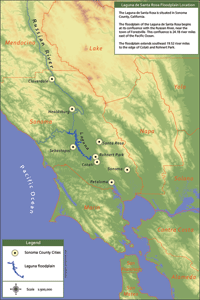A local story
This web site and the book, "Another New Year's Eve Freshet," take a look at one place during those eventful days in 2005—2006: the floodplain of the Laguna de Santa Rosa. It is based on personal observations and published data.
Other places have their stories as well, as attested to in the Press Democrat archives: Napa watching in anxiety to see if their partially complete river project would work as expected; Santa Rosa monitoring the Spring Lake diversion as it approached capacity; Rohnert Park residents waking in the middle of the night to see manhole covers popping from backwash; Petaluma stunned by new areas of unexpected flooding; Hopland awash in the highest waters in decades; Sonoma County school districts delaying the return of students to clean up flood debris; mudslides and road damage throughout the county; and of course, all the Russian River communities racing for high ground in the days before the flood, and then toughing it out—isolated from the rest of the world—for four days and nights.
 Those stories portray the scale of the event, covering the Mendocino, Sonoma, Marin and Napa county area. But rainfall gauges throughout the region, better demonstrate the magnitude of the storm, and place its center atop Taylor Ridge near Sonoma Mountain, and Taylor Ridge is the southern headwaters to some of the Laguna de Santa Rosa’s major tributaries.
Those stories portray the scale of the event, covering the Mendocino, Sonoma, Marin and Napa county area. But rainfall gauges throughout the region, better demonstrate the magnitude of the storm, and place its center atop Taylor Ridge near Sonoma Mountain, and Taylor Ridge is the southern headwaters to some of the Laguna de Santa Rosa’s major tributaries.
For me, the big story in all of this, is the Laguna de Santa Rosa. And the big questions are, how did this flood compare to earlier floods, where have conditions changed, and are we prepared for the next one? The rest of this book provides one perspective.
Like other similar floods, this one came after several days of sustained and intense rainfall, and it predictably played out in a textbook fashion. Curiously, the most recent flood of this size also began on the eve of a new year, reaching its crest on January 1, 1997. Many of the area’s long-time residents can also recall the big waters of January 9, 1995 and the even bigger waters of the Valentine’s Day flood of 1986. And before that the record books tell us about the two Christmas Eve floods of 1964 and 1955.
Biggest? Maybe not, according to stage and discharge gauges. Most dangerous? Probably not, since years of experience has taught us how to predict and prepare. A harbinger of changed climate conditions? We will see.

